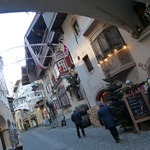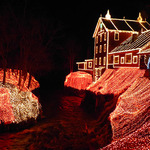A climb up the towering Belfort (belfry or bell tower) in Bruges, Belgium is not for the faint-hearted. The belfry towers high above the other buildings in this UNESCO World Heritage city, and there are are 366 steps to climb to reach the viewpoint over the main square in Bruges. On the way, you will encounter many bells and the drums and mechanics of the bells in use.

Bruges was once a very wealthy medieval city, so it constructed this belfry to match its status. The bottom hall to the middle part of the tower was constructed in the 13th century, but the square generally had extensive building works, and to the east of the tower was the Waterhalle, which was built above the canal and used as a warehouse for storing goods shipped to Bruges from the canals. The tower was refurbished in the mid-1900s.


One of the rooms in the hall of the bell tower holds iron gates with chests, which stored important documents of the city.

The clocks were only installed on the tower in the 15th century. Before this, the bells would be rung in order to mark the hours of the day. This was done manually. When the clock was installed, it could automatically ring the bells. The number of bells increased so that different types of chimes could have different meanings. The bells have been replaced a few times due to breaking or lightning hitting the tower. In the mid-1800s, belfry concerts were organised in the square in the summer, and this inspired many artists to write about the charm of Bruges' bell tower. Henry Longfellow wrote the poems "Belfry of Bruges" and "Carillon" about the tower, and it was also a feature of Georges Rodenbach's novels.

The drum or carillon is a nice bit of kit that allows the chimes to be changed for concerts or special occassions. It works similar to a music box. The chimes are changed every two years.

Today, the great bell is called "De Croser Maire Fit Construire de Beffroi", and it dates to 1809.

Because it is one of the most well-known attractions in Bruges, the bell tower is a popular attraction. For this reason, I suggest an early morning visit or a visit later in the day in order to avoid the queues. I visited it at about 10:00 in the morning in late March, and I did not have to wait. March during the week in the morning is not in the high tourist season. However, I saw that the bell tower was much more popular on a weekend in the morning at about 11:00. Only a certain number of people can visit at a time, and do note that there's one staircase for all to use after a certain point.

There were two or three levels of the hall with a selection of bells and information about the tower before climbing more stairs.

At the top, I was rewarded with the beautiful views over Bruges. When I first arrived, there was a little bit of fog, but this cleared pretty quickly to reveal full sunshine.







So, what is it like climbing the tower? The last 25-30 steps are pretty narrow but manageable, and the tower is completely enclosed, so people who dislike heights should generally be okay with getting to and enjoying the view from the top. Taking photographs is difficult, though, because wire has been put up to prevent items from falling out.



I recommend climbing to the top of the bell tower in Bruges and enjoying the view. Have you been to Bruges and climbed the tower?



Leave a comment